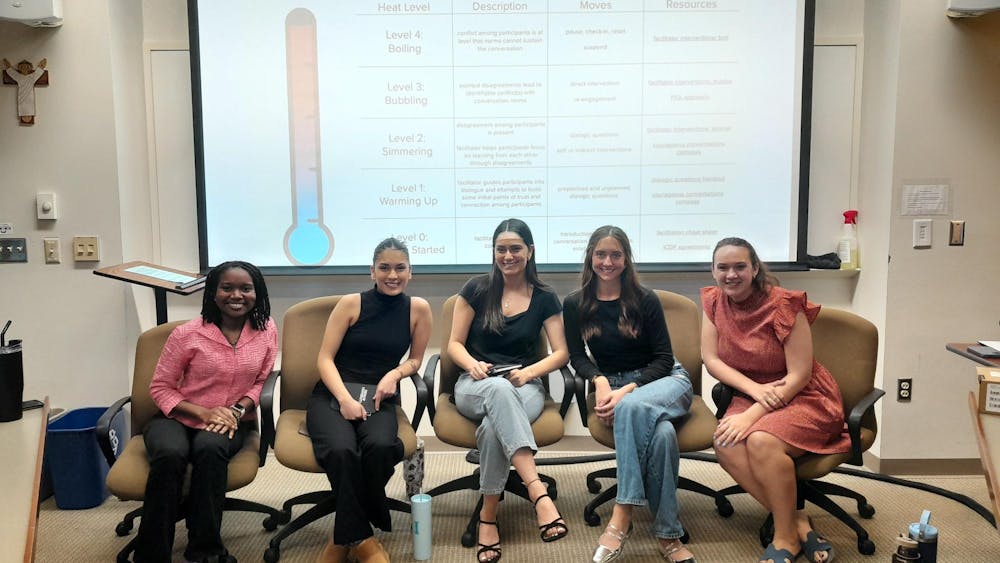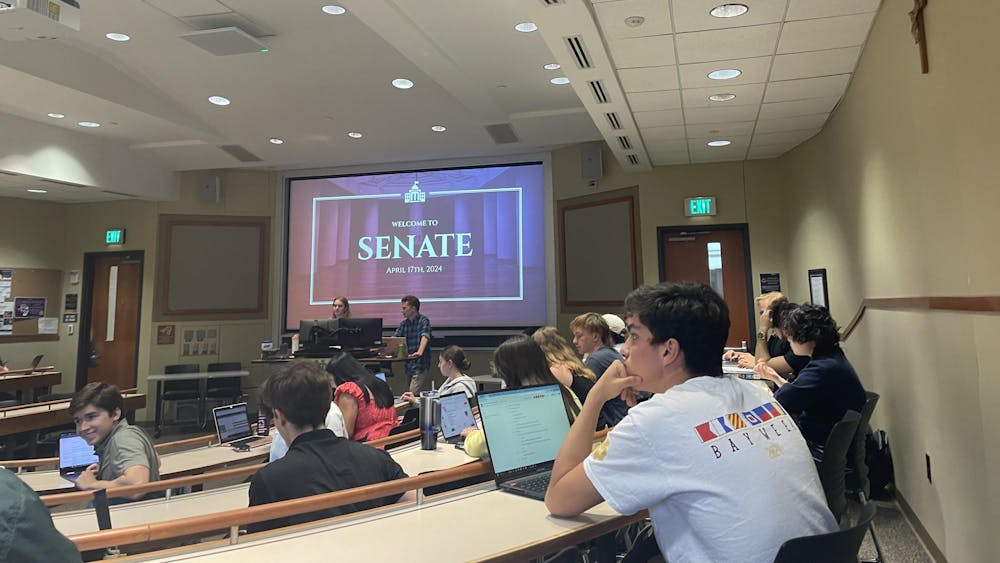Saint Mary’s welcomed visiting artist Curtis Readel for a special lecture and class event Monday in Vander Vennet Theatre, art department chair and this semester’s visiting artist coordinator Krista Hoefle said.
Readel received his BFA from the University of Iowa and an MFA from Northern Illinois University with an emphasis in printmaking, and exhibits his work nationally from Brussels to Estonia, Hoefle said.
Readel said his ongoing studio practice addresses themes and ideas focusing on social and political issues. From distorted images, his art explores societal downfall, government corruption and self-indulgence in mediums such as printmaking, collage and drawing, he said.
“I started out as a print-maker and I consider myself a printmaker through and through,” Readel said.
Readel worked and posed his friends with a certain historical and religious reference in mind for his first series, “Business As Usual,” he said.
“I lifted [a pose] from Dante’s ‘Inferno,’" Readel said. "The engravings were these very detailed and psychologically in-depth with the idea that people were wanting money and wealth. I started thinking about how this hunger for money could be conveyed. I decided that I needed to undergo it myself to not only feel the psychological toll, but the physical toll as well.”
He didn’t have access to the type of printer he needed for his work, but he continued to save his art for when he would, he said.
Readel said aside from his experimentation with graffiti stencils, he uses little color in his work for the sake of his message.
“It’s not that I don’t know how to use color," Readel said. "By ridding [the piece] of it, I’m bearing the graphics of it.”
Readel’s graduate professors emphasized an appearance of professionalism in displaying his work, he said.
“I spent a lot of money framing my work so it looked really well done," Readel said. "With my proximity to Chicago at the time, I would take my work into galleries and shop around for representation.”
One of his most successful pieces is a disfiguration of a degutted, all-seeing eye on the back of the one-dollar bill with the Latin phrase "sic semper tyrannis" engraved above it, he said.
"It’s actual translation is actually, ‘And thus, always tyrants,’" Readel said. "You can interpret this as maybe the eye of the tyrant and now we’ve dealt with that tyrant, or was the eye blind to the fact that tyranny exists. This is also the first time that I’m used subliminal messaging in my work.
"I teach graphic design and I’m really interested in what are known as imbeds which are targeted to primal feelings. I wrote ‘buy me.’ I wrote it backwards and forwards. I also wrote a lot of four-letter words. So all the chatter and secondary mark-making in the eye is actually all distorted. I attribute it to having done some good studies."
Readel said several United States Federal Reserves supply him with shredded dollar bills collected in small plastic bags for his artwork. Another favorite element Readel incorporates within his artwork is the image of the human skull, he said. The skull is a prominent proponent within his series, “Dead White Guys From History,” where he disfigures the faces of George Washington, Benjamin Franklin and Abraham Lincoln from the front face of U.S. currency with skulls, he said.
With a tongue-in-cheek approach, Readel’s work is often accused of being unpatriotic, he said. He refers to himself as a political atheist, saying he work is meant to interpret what the Founding Fathers originally envisioned for the United States, he said.
“In my research of history, especially empires throughout history, every known empire has failed. Rome, the Aztec and at one time or another, they were the largest, wealthiest superpower," Readel said. "By their own demise, they weren’t. I feel the United States is a world power on the great precipice of having to make an important decision. We can either go the route of other empires and stretch ourselves too thin economically, or we can focus on what’s best for the long term. I personally don’t see that happening now. I hope my work can start a discussion about that.”













